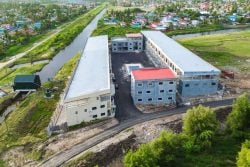Oil Spill Response Limited (OSRL) has posted vacancies for their new operational base in Guyana, following the July commissioning of a state-of-the-art capping stack designed to seal any offshore spill here.
The new capping stack, installed at the Guyana Shore Base Inc. (GYSBI), is one of only six provided by OSRL globally and one of just two in Latin America. This advanced equipment, built by Trendsetter Engineering, is crucial for managing and mitigating oil spill incidents. ExxonMobil Guyana is the subscriber to this regional capping stack service, having leased the equipment as part of a new regional service agreement. Its subscription comes after years of concerns here that a spill in the Atlantic would have catastrophic consequences as Guyana has no capacity to respond.
Andy Myers, OSRL’s Response Director, commented on the significance of its base here in a press statement posted on the company’s website, “The arrival of this advanced equipment underscores our unwavering commitment to our members and to mitigating the impacts of oil spills worldwide. This development highlights our dedication to enhancing global oil spill response readiness.”
The establishment of the new base in Guyana aligns with OSRL’s Long-term Strategy to bolster operational capabilities and support an integrated response function across the Americas region. This initiative was in response to the Guyanese government’s mandate for Subsea Well Intervention equipment, leading to the deployment of the capping stack and a heavy shears kit for debris removal earlier this year.
Looking forward, OSRL plans to further expand its capabilities within Guyana. Vicente Allevato, Americas Regional Manager, outlined future goals, also stated in the press release, “We are planning to enhance our in-country surface and dispersant response capabilities as part of a more comprehensive emergency response offer. This expansion will strengthen our ability to effectively address oil spill incidents in the region.”
To support these efforts, OSRL is actively seeking qualified candidates for two key positions at the new base: Guyana Response Manager and Guyana Base Administrator.
Guyana Response Manager
The Guyana Response Manager will oversee base operations, ensuring equipment readiness and managing the local response team. Responsibilities include:
– Establishing and developing the OSRL Guyana base.
– Ensuring operational safety, including risk assessments and adherence to safety regulations.
– Coordinating maintenance and repair of base infrastructure and equipment.
– Hosting visits from members, regulators, and stakeholders.
– Managing the implementation of the Oil Spill Response Integrated Management System and maintaining ISO 9001, ISO 14001, and OHSAS 18001 accreditations.
Candidates should have excellent communication skills, a strong safety ethos, and a willingness to be on-call. A proactive attitude, practical problem-solving skills, and the right to live and work in Guyana are essential.
Guyana Base Administrator
The Guyana Base Administrator will provide crucial administrative support for base operations. Key duties include:
– Managing procurement processes, including purchase orders and supplier agreements.
– Handling financial tasks such as banking transactions, reconciliations, and expense management.
– Offering general administrative support, including arranging meetings and maintaining filing systems.
– Assisting with human resources functions, including recruitment and training coordination.
The role requires strong business administration skills, previous office management experience, and good IT literacy.
A capping stack acts a well plug and takes similar action to that of a bottle cap. ”A capping stack is a large piece of equipment that can be placed over an oil wellhead in the unlikely event of a spill. The stack acts like a cap to stop an oil leak until engineers can permanently seal the well. It can connect to and cap virtually any subsea wellhead in the event the well’s built-in blowout protector safety device fails,” ExxonMobil explained in July on a fact sheet about capping stack technology.
It is part of a larger spill-containment system, ExxonMobil explained, adding, “The new Guyana-based capping stack is the centrepiece of a larger emergency response and spill containment tool kit that ExxonMobil Guyana would deploy in the unlikely event of a spill. Other mitigation measures that ExxonMobil Guyana can readily deploy alongside the capping stack include, but are not limited to, containment booms, skimmer devices, oil dispersants, helicopter surveillance, and surface and wildlife response.”
OSRL’s efforts are supported by a diverse group of members from across the global oil and gas industry. Key participants include major players such as: ExxonMobil, BP, Chevron, Shell, TotalEnergies, Equinor, Petrobras, ENI and others.






